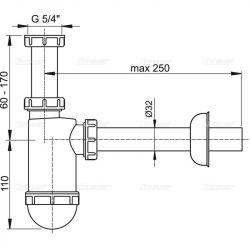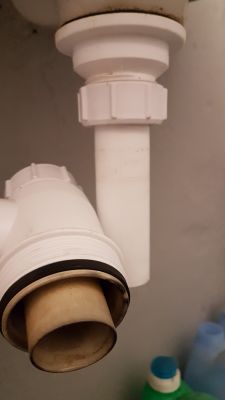FAQ
TL;DR: “5 cm of water = 0.005 bar” is your odor barrier; fix sink smells by cleaning the overflow, servicing or replacing the siphon, and confirming the trap’s water seal. Persistent odors can indicate venting issues. [Elektroda, ziemek56, post #18138633]
Why it matters: This FAQ helps apartment dwellers with older plumbing pinpoint and fix sewer-odor sources fast.
Quick Facts
- For non-baffled bottle traps, keep the inner tube submerged ≈50 mm; 5 cm water equals 0.005 bar of seal. [Elektroda, ziemek56, post #18138633]
- Some modern bottle traps have internal partitions, so immersion depth is less relevant—check the design. [Elektroda, piracik, post #18138308]
- Overflow channels trap hair and slime; a thick cleaner solution works and may need repeating. [Elektroda, palmus, post #18138788]
- New siphon cost was < PLN 30 in-thread, and replacement eliminated lingering odor. [Elektroda, Htomas, post #18144741]
- Clogs often sit at the wall inlet; disassemble and clean carefully, especially after using chemical “mole.” [Elektroda, hugonot11, post #18142118]
How do I quickly tell if the odor comes from the overflow or the drain?
Do a stopper test. Block the drain tightly and sniff near the overflow. If smell remains, clean the overflow. If smell stops, inspect the trap and wall inlet. “Block the sink with the stopper and the problem will disappear, unless the stench hits the overflow.” [Elektroda, Rezystor240, post #18138324]
What immersion depth should the vertical tube have in a bottle trap?
For non-baffled bottle traps, keep the downpipe at least 5 cm below the waterline to maintain the seal. That water column resists sewer gas pressure. “5 cm of water = 0.005 bar.” If the seal drops, odors pass. [Elektroda, ziemek56, post #18138633]
My trap has an internal baffle—does tube immersion depth still matter?
Baffled bottle traps create the seal internally, so visible immersion of the tube matters less. Verify by checking the trap’s diagram or manual. “This chamber is divided inside.” Still ensure the trap always holds water after use. [Elektroda, piracik, post #18138308]
How do I clean a sink overflow without it just draining away?
Use a thick, gel cleaner and let gravity work.
- Insert the drain stopper and fill the basin to cover the overflow slot.
- Using a funnel, pour a thick solution into the overflow.
- Wait, then flush with hot water; repeat if needed. “The thick solution will do its job.” [Elektroda, palmus, post #18138788]
What cleaning steps actually solved the odor in this thread?
The fix combined deep cleaning and a new trap. The user pulled gray goo with a wire, soaked the drain with enzyme cleaner, replaced a seized siphon, then ran water with the plug in and rechecked. No muck returned and the smell stopped. [Elektroda, Htomas, post #18144741]
Do enzymes or hot water alone fix sink odors?
They can help temporarily, but not cure buildup. One user ran hot water for 30 minutes, then dosed 100 ml of enzyme overnight. The odor returned in days until deeper cleaning and trap service were done. Treat the source, not just symptoms. [Elektroda, Htomas, post #18137174]
Should I also clean the sewer inlet in the wall?
Yes. Hair and debris often sit at the wall inlet and can smell. Remove the trap, inspect the wall socket, and clear buildup. If you previously used strong chemicals, disassemble carefully and rinse thoroughly for safety before scrubbing. [Elektroda, hugonot11, post #18142118]
Can AC-foam (e.g., K2) help clean the overflow?
Yes. One user foamed the overflow with K2 AC cleaner, waited, then flushed hot water. Combined with trap cleaning, this removed the smell. Foam clings to vertical passages and breaks biofilm in the overflow channel. [Elektroda, Htomas, post #18142354]
What if trap fittings are seized—replace or force them?
Replace them. Forcing can crack old plastic. The user could not loosen the screw even in a vise and bought a new siphon for under PLN 30, which resolved the odor. New seals and plastics restore reliability. [Elektroda, Htomas, post #18144741]
Could venting or a blocked stack cause recurring odors?
Yes. A blocked vent stack can pressurize gases and push odor past a weak seal. Birds or debris can obstruct the vent. Maintain a solid water seal in the trap to resist pressure differences and call a pro if it persists. [Elektroda, ziemek56, post #18138633]
Could the ceramic sink itself be the cause?
Rarely, yes. A faulty basin can trap water between cast layers and smell. One case only surfaced after removing and dissecting the basin. If all else fails, inspect or temporarily swap the basin to rule this out. [Elektroda, palmus, post #18142353]
How do I clean the siphon properly?
Remove and scrub it. Place a bowl, unscrew the trap, clean all parts, and reassemble with fresh seals if needed. Rinse thoroughly before reinstalling. This often eliminates odors that the trap itself harbors. “Perhaps it is worth cleaning the siphon itself.” [Elektroda, KapitanSTS, post #18138336]
What do diagrams showing 110 mm tube extension and ~90 mm water level imply?
They suggest the trap’s sealing is internal. One manufacturer diagram allowed the tube to extend 110 mm above the base while water sat around 90 mm, implying a baffle or inner tube provides the seal. Check your model’s schematic. [Elektroda, piracik, post #18138781]
Once fixed, how do I confirm the smell is gone?
Run water several minutes with the plug in, then probe the drain with a wire. If no gray slime returns and no odor appears the next day, the fix holds. Recheck overflow and wall inlet if odor recurs. [Elektroda, Htomas, post #18144741]





